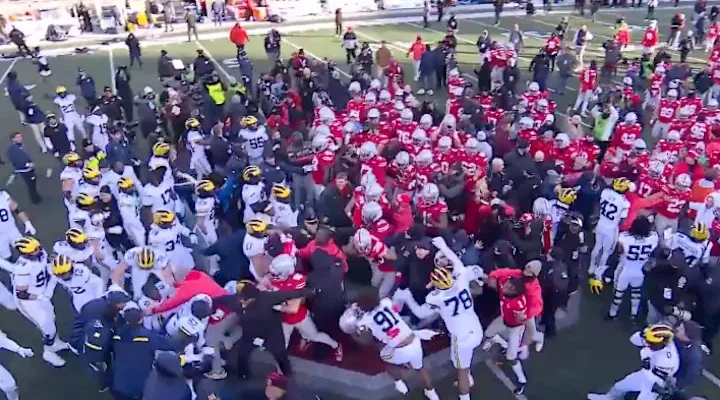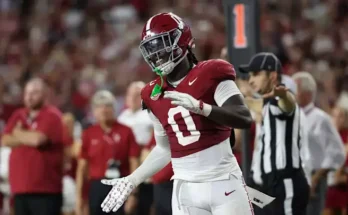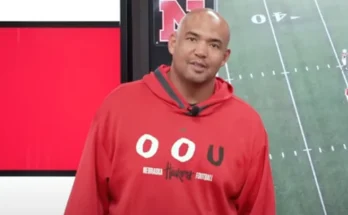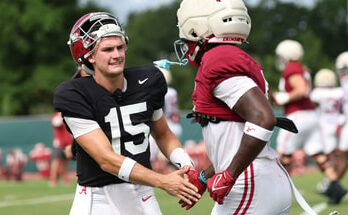How Michigan’s Flag Planting at Ohio State Sparked Chaos, Fueled Rivalry Fire, and Cost Both Programs Hundreds of Thousands of Dollars
In college football, few rivalries carry the weight, history, and emotion of Michigan vs. Ohio State. Known simply as “The Game,” it’s a yearly clash that transcends records, standings, and expectations. It defines legacies, decides championships, and cements or destroys seasons. Over the decades, this battle between two Midwest titans has produced countless iconic moments—some celebrated, some controversial. But in 2024, a new chapter was written, one that veered from passionate tradition into explosive chaos. Michigan’s symbolic act of planting their flag at midfield in Ohio Stadium didn’t just mark a symbolic victory—it sparked a postgame brawl and unleashed a storm of consequences, both emotional and financial, for both programs.
It was November 30, 2024, and the stakes couldn’t have been higher. Michigan entered Columbus undefeated and seeking to extend its win streak over the Buckeyes, while Ohio State hoped to reclaim bragging rights and reinstate its dominance at home. The game was gritty, physical, and as intense as any in recent memory. With College Football Playoff implications hanging in the balance, every drive, every tackle, and every point carried the weight of decades of rivalry baggage.
But when the final whistle blew and Michigan had secured its third straight victory over the Buckeyes, the tension that had been building throughout the game erupted—not just among fans, but on the field itself. Fueled by adrenaline, passion, and a desire to make a statement, several Michigan players stormed to the iconic Block “O” at midfield and planted their team flag right into the heart of enemy territory. It was a deliberate, defiant act—one that symbolized not just victory, but conquest.
To the Wolverines, it was a statement of dominance. To the Buckeyes, it was an unforgivable insult.
The reaction was immediate. Before the flag could even settle into the turf, Ohio State players rushed to confront their Michigan counterparts. Shoving quickly turned to punches, helmets were ripped off, and chaos unfolded in front of a stunned national audience. Coaches and staff from both sidelines stormed the field to break it up, but the damage had been done. What should’ve been a triumphant exit for the victors and a moment of reflection for the losers devolved into a spectacle of animosity and aggression.
Within hours, videos of the brawl spread like wildfire across social media. Clips of players throwing punches, others trying to hold teammates back, and the flag standing defiantly on Ohio State’s logo became instant fodder for talking heads, fans, and analysts. Opinions were divided. Some applauded Michigan’s bravado, calling it a rightful celebration of a hard-fought win on enemy soil. Others condemned it as classless, a sign of disrespect that crossed a line even in the most heated of rivalries.
The Big Ten, however, made its stance clear. After conducting a thorough investigation that included video analysis, player interviews, and sideline footage, the conference came down hard on both programs. A total of eight players—four from each team—were suspended for one or more games. Additionally, both Michigan and Ohio State were hit with six-figure fines, each exceeding $100,000. The conference cited “failure to maintain control” and “unsportsmanlike conduct” as primary reasons for the penalties.
These weren’t just symbolic slaps on the wrist. The fines were among the largest ever levied in the conference’s history for postgame behavior, signaling a firm stance against unsportsmanlike incidents, regardless of their emotional context. While neither school appealed the decision publicly, the repercussions extended beyond finances and suspensions. Both athletic departments faced internal pressure, with calls for better sideline control and renewed emphasis on sportsmanship protocols.
But the fallout wasn’t limited to disciplinary action. The incident reignited a broader debate about college football culture and the boundaries of emotional expression in high-stakes games. Where is the line between celebration and provocation? Does passion excuse postgame taunting? And in a sport that thrives on rivalries, how much hostility is too much?
For Michigan, the flag-planting became a symbol of confidence, a tangible representation of their recent dominance in the rivalry. Head coach Sherrone Moore, while not directly condoning the act, later addressed the media with a nuanced stance. “Our players were emotional. They played their hearts out in one of the biggest games of their lives. But we have to handle success with class. That’s something we’ll address internally,” he said.
Ohio State’s Ryan Day, visibly upset during the postgame press conference, took a more hardline tone. “There’s a way to win. And there’s a way to lose. What happened after the game was unacceptable. We’ll use it as fuel. This isn’t over.”
That sentiment—that this moment will live on—was echoed by players and fans alike. For Ohio State, the incident became a rallying cry. Social media lit up with Buckeyes promising revenge in 2025. Alumni weighed in, with former players like Ezekiel Elliott and Cardale Jones posting messages of defiance and unity. For Michigan, the moment became part of a growing sense of swagger and belief that the balance of power in the rivalry had truly shifted.
And that’s what makes the incident so compelling—not just the immediate aftermath, but what it represents in the larger context of the rivalry. For much of the 21st century, Ohio State had dominated The Game, often by large margins and with little resistance. But since 2021, the tide has turned. Michigan’s recent string of victories—including two in Columbus—has transformed the narrative. No longer are the Wolverines the plucky underdogs hoping to keep it close. They’re the aggressors now, and the flag-planting was the exclamation point.
Yet with that shift comes new responsibilities. Being on top means being the standard-bearer. It means winning with grace, not just grit. For all their deserved pride in recent success, Michigan now faces the challenge of maintaining control and setting an example. Acts like the flag-planting, while thrilling in the moment, can easily backfire. Opponents remember slights. They circle dates. They use moments like these as motivation. And in rivalries as fierce as this one, that edge can make all the difference.
The 2025 installment of The Game is already shaping up to be one of the most anticipated matchups in recent memory. With both teams expected to be playoff contenders again and with emotions still raw from last year’s fracas, the stakes will go beyond wins and losses. Pride, redemption, and legacy will all be on the line. You can be sure that the images of the planted flag and ensuing melee will be shown on video boards, in locker rooms, and on television promos for months leading up to kickoff.
For college football as a whole, the incident serves as a reminder of the sport’s dual nature—its ability to inspire both extraordinary camaraderie and volatile conflict. Rivalries are essential to its identity, and emotion is part of what makes the game so compelling. But passion must be balanced with restraint. The challenge for players, coaches, and fans alike is to find that balance, especially in moments of triumph or despair.
Looking ahead, both Michigan and Ohio State have made moves to prevent similar incidents. Security presence will be increased for future games, postgame protocols will be tightened, and players will undergo more education on sportsmanship. Yet, even with all these measures, the rivalry’s intensity isn’t going anywhere. If anything, it’s only getting hotter.
The flag-planting of 2024 will live on in college football lore. It was a moment of raw emotion, of territorial triumph, and of symbolic power. But it also showed how quickly passion can boil over into chaos, and how even the most time-honored rivalries must be tempered with discipline.
In the end, Michigan’s bold statement came at a price. A costly one, both financially and in terms of reputation. But it also set the stage for the next chapter in college football’s greatest rivalry—a chapter that promises to be just as fiery, just as emotional, and perhaps even more unforgettable than the last.



